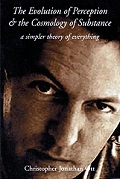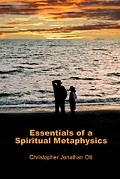 |
 |
 |
| Home | Essays |
Wikipedia | Resources | Portals & Archives |
|
Perception |
|
||||||||||||
|
The Evolution of Perception & the Cosmology of Substance A simpler theory of everything by Christopher Jonathan Ott |
|||
|
|||
|
"Long ago, before he had the complicated metaphysical theories that he has today, man had his experience to explain. Over time, he invented theoretical entities to explain his experience. He invented gods, the logos, forms, matter, monads, noumenon, minds, spirit, the ether, spacetime, superstrings, dimensions, etc. Gradually these invented things became the things which required explaining. Great arguments were generated to explain them, to prove the existence of the entities he had invented to explain experience. Gradually man began to question experience itself, since it no longer seemed compatible with his theories. Experience, that event which had once been beyond dispute and the starting point of man's inquiry, was now the theoretical entity, and his invented entities, such as matter and energy, for which he had no direct evidence, were reality. The world was finally totally upside down."
(excerpt from "The Evolution of Perception") Chris Ott considers our current philosophical problems to be the tragic result of psychological fallacies as old as Plato. He offers a new explanation for the universe that relies simply on an evolution of perception. His theory succeeds at accounting for the physical as well as the psychological--including mathematics, natural law, concrete objects, language, thought, and culture. A spellbinding journey to the roots of our assumptions. (editorial review, Amazon.com) |
Essentials of a Spiritual Metaphysics Seeing Through and Seeing As, The Holy Book of Science, and other works by Christopher Jonathan Ott |
|||
|
|||
|
"Metaphysics is the area of philosophy that deals with problems that the human brain wasn't really created to understand. When we were cavemen and our brains were evolving, we were dealing with physical objects like food and water, sticks and stones. So we were born into this world adapted to a harsh physical world, making objects and counting beads, not for the fine subtleties of abstract ideas. So there is nothing so natural as having trouble with metaphysics for an ordinary man. But just as there are finer thoughts than merely counting beads, there are finer faculties latent within man that, in the course of time, can gradually be unlocked and put to use." (excerpt from "Speaking Plainly") The history of this digital book goes all the way back to my first book. Right after I published EOP I knew that I wanted to depict it in pictures - and soon after June 2004 when EOP came out, I started doing those charts. I slowly realized that except for very few seekers of a specific mental discipline, no one had any idea what EOP was trying to say. So I wanted to write something that both clarified and tied this to the spiritual thinking that gave birth to it. Finally, only after I wrote EOP did I discover Advaita Vedanta, Emanationism, Illuminationism, and read Infinite Intelligence. So only after did I realize that while this was missing from "science" and "philosophy" of the Universities, mystics had always known this. These realizations were also at the heart of making a new book. (adapted from an email of Chris Ott to Stelios Karavias) |
The Evolution of Perception in Diagrams Diagrams by Christopher Ott Text by Stelios Karavias |
|
The book "The Nothing And The Everything" starts with the poetic metaphor of the Infinite and Shoreless Ocean. It is the Ocean of Infinite Knowledge and Infinite Intelligence. It is the Ocean that existed before the apparent universe and that exists eternally beyond it. It is the tranquil and motionless Ocean that exists before and beyond the arising of consciousness. It contains the Everything and in the Everything is also contained the Nothing. But although it contains the Everything, it is not conscious of anything, including Itself. It is within the Nothing that a very first notion of awareness is expressed. It is the notion that "I am nothing" which gives rise to the notion of "Who am I?" and in its turn this notion produces the first stirring in the Nothing, though no stirring ever takes place in the Everything. This stirring results in the OM point. A point from which the Nothing starts projecting "out" of the Everything and becomes its shadow. It is from processes within this projected Nothingness that consciousness arises. First it arises in very rudimentary forms, so rudimentary that we can hardly understand it as consciousness, but then it evolves gradually into the form of consciousness we human individuals posses. Eventually some individuals come to inquire about their own self and about consciousness itself. And eventually, this leads to the realization of the Self as the Infinite Ocean. Through his philosophical work and his later collected explanations of it, Chris Ott is turning his focused attention on the evolution of perception, which is no less than the history and process by which Consciousness arose within Unconsciousness. Here are diagrams Chris made to elucidate on the subject. The first one describes the whole process, from the very first "ordering" of imagination through the "perceptual schema" of Time, up to the whole complex array of "lenses" through which human individuals perceive "the world out there", or their "Percept". |
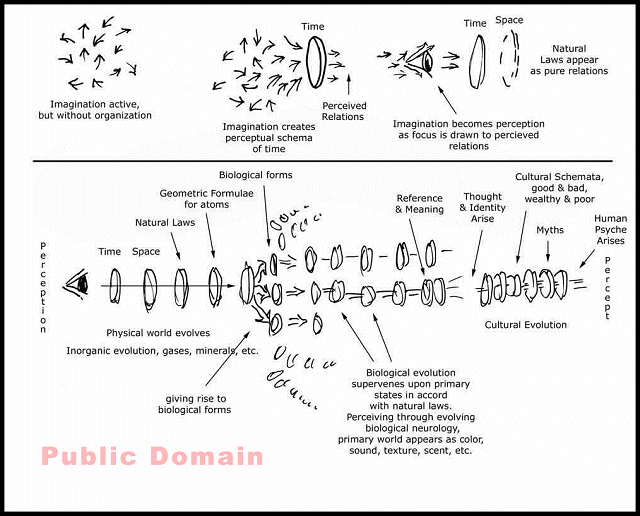 |
|
The one issue that arises here is concerning this "eye" on the left. In the next diagram it is termed "Eye of God". Let's make a few things clear for believers, skeptics, agnostics and atheists as well. This is a symbol we use because for us an eye indicates "seeing", "perceiving". It is not a biological organ suspended in mid-air. And "God" is a word by which we mean "not the individual", but rather the collective (in whatever state of consciousness or unconsciousness). Terming it "God" might make some feel like it is the Eye of some bearded Abrahamic God hiding behind some very dense clouds. This is not the intention here. Actually we perceive our Self as the one-who-is-behind-the-eyes. And indeed when the whole who-is-who riddle is solved, who one really turns out to be is not a brain behind a pair of biological eyes, but this "I Am" which is before and beyond the whole array of "lenses" (perceptual schemata). |
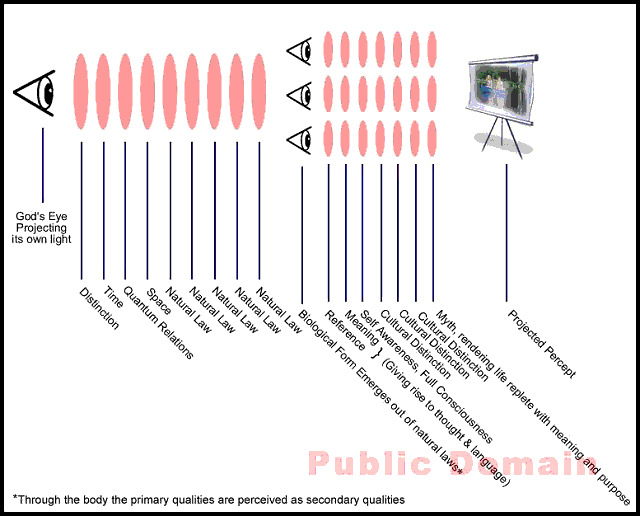 |
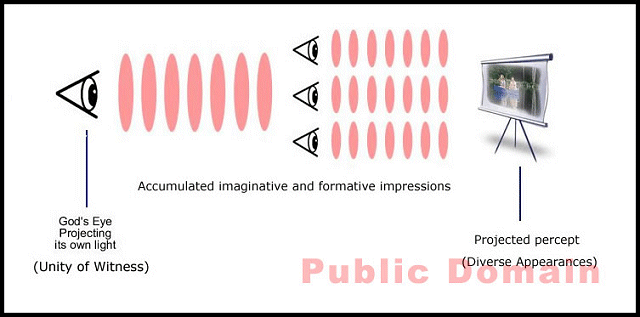 |
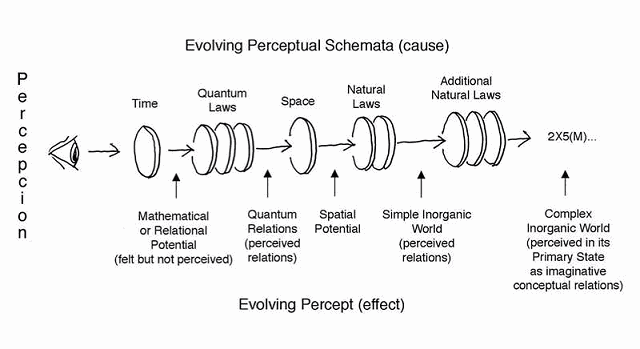 |
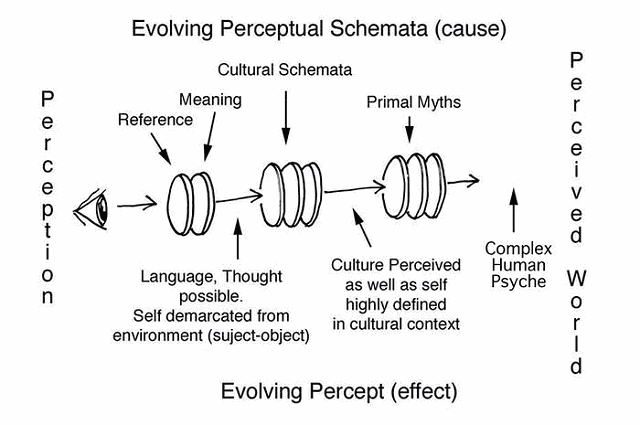 |
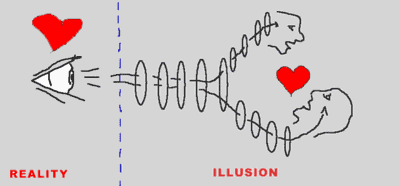 |
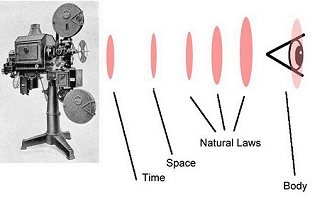 |
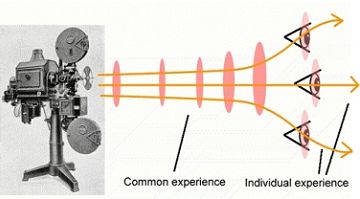 |
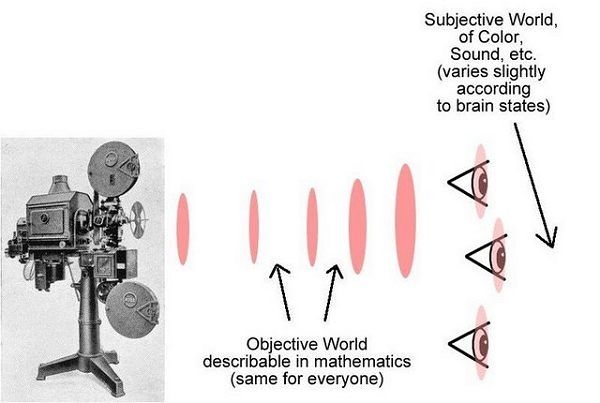 |
Download further diagrams and explanations by Chris Ott here: (link to MediaFire free download) A Model of Perception Back to Contents |
Why things feel solid by Christopher Jonathan Ott |
People might wonder why, if physical objects are fundamentally perceptual, they look and feel solid. The answer is simply that they are solid. But to understand this we have to consider what it is we're really conveying when we say objects are 'solid'. 1. We mean those objects have extension. In other words they occupy a certain amount of space, to which we assign a numeric value relative to other objects in their environment. Such relative measurements are mental properties, for they conceptually describe relations experienced sensorially through the perceptual organization of the mind. Such measures are then assessed, judged, and named by the mind. The very notions of spatial ratio and numeric value are themselves mental concepts.
1. We mean those objects have extension. In other words they occupy a certain amount of space, to which we assign a numeric value relative to other objects in their environment. Such relative measurements are mental properties, for they conceptually describe relations experienced sensorially through the perceptual organization of the mind. Such measures are then assessed, judged, and named by the mind. The very notions of spatial ratio and numeric value are themselves mental concepts.2. Objects feel heavy. By this we mean objects press themselves toward the center of the Earth under the influence of gravity. When we say we 'feel' this, we mean quite literally what we say - that we take the experience of pressure upon our skin and muscles as those objects press upon them on their path toward the Earth. This is to be expected from objects that are formed through the perceptual schema of gravity through which we are seeing and touching them. Of course objects in our experience will behave in terms of the perceptual laws upon which that experience supervenes. 3. Objects are hard. Again, what do we mean precisely when we say this? We mean that when we touch an object our hand cannot pass through it, but instead meets resistance. This grants to us the experience that we call 'hard'. Again, this is simply the natural perceptual laws of electromagnetic attraction and repulsion through which we are experiencing the object. Of course objects we perceive will behave by the quantifiable perceptual laws they supervene upon. 4. We feel them on our skin. We must of course again examine what we mean by this. As already stated, when I touch an object, the laws that govern all experience are such that I experience my skin meeting resistance. Stone has most resistance, water has less, air even less and so forth. The degree of this resistance that I experience gives to my mind the feeling of an independent object. It is not, as our gross intuitions convince us, the object that gives to the mind the feeling of its presence. Rather it is the reverse. The sensation of touch gives to the mind the feeling of its presence. In short, the mind interprets its sensations as representing to it a world independent of sensation. But in truth objects simply are their sensation. 5. They appear solid to our eyes. What do we mean when we say we see something? We mean we see color. Color is not them, nor even a property of them, but is an interpretation of frequencies of energy experienced as brain states through a perceptual schema. In other words certain frequencies of radiation are interpreted by the mind as red, others as blue, etc. What we see are our brain states. This is just basic perceptual physics. 6. Sometimes by 'solid' we mean that unlike a dream that vanishes quickly upon waking, which we say is not solid, solid objects persist. That is to say, they last. Actually all physical forms are impermanent. They simply last longer than dreams. Paper, metal, wood, all waste away with time. Stones last billions of years, but in time even stones wear to dust. Of such long term but not eternal persistence, what else would one expect of objects that are governed by the perceptual laws upon which they supervene? The degree to which those objects last or perish is determined by the natural laws that govern their mechanics - which are laws of perception. 7. Their material is permanent even if they are impermanent. Science and reason tell us that the material out of which objects are made is what is permanent, even if those objects are impermanent. So at least the material must be solid. We'll give a bit of explanation of this idea. It is usual to speak of a primal stuff or substance that is malleable. A substance that is malleable is soft and can easily be made into different shapes. This stuff it is always assumed is what is eternal, and it is the forms that are molded from that substance that arise and then decay. The material that is formed, however, is permanent. This is true. In materialism that substance is a theoretical stuff called "matter" that cannot be perceived with the senses, and thus cannot be verified by observation. But in this new view, the malleable substance is perception itself, an activity which cannot be denied without self-contradiction. It is our perceptual activity that molds itself into those objects that we perceive. Thus perception is what is permanent, and the objects that it forms itself into that are impermanent. By the perceptual laws (natural law), that govern our perception, those objects and materials persist for a duration determined by those natural laws. 8. They feel hot or cold. The sensation of heat has everything to do with thermal laws, and nothing to do with anything else. When molecules vibrate, this causes the nerves in our skin to vibrate. Vibration is then interpreted by the brain as heat. Faster vibration is experienced as heat, slower as cold. There is nothing that is hot or cold. There is fast and slow vibration. Vibration, which we call energy, is necessarily most fundamentally mental. For what is vibrating? Nothing. Vibration precedes and forms the sensation of a thing. Thus it is not an object that vibrates, but vibration that forms the appearance of an object in the brain - with sensations such as heat. 9. Their properties can be measured with instruments. For instance we can measure weight, light, sound, and temperature with certain types of meters and scales. Let's see how this is consistent with objects taking their life from perceptual schemata. If we place a thermometer in a bowl of boiling water, the molecules in the mercury within the thermometer vibrate. This jiggling of the molecules causes those molecules to separate from one another, like ping pong balls separating in a wooden barrel that is shaken. This separation of the molecules causes the volume of space taken up by the mercury to increase, causing the meter to rise. This gives us a predictable and repeatable reading of the temperature of the water using a thermometer. However, both the thermometer and the bowl of water are seen in our experience. Our perceptual schemata concerning physical vibration, expansion, and the sensation of heat which apply to the water also apply to the thermometer. Thus they go up in tandem as would be expected. For they are all three conditioned by the same schemata - which are schemata of our perception. 10. The most obvious point of calling something solid might be that it isn't hollow. solid: having the interior completely filled up, free from cavities,I put this most usual sense of the word 'solid' last because I thought it least likely to confuse anyone. Anyway, in case it does, the same principles repeated above apply. All the properties of objects are latent in the schemata (organization) through which they are perceived. Natural laws are perceptual laws, including those that apply to mass and density. So everything is interpreted thought, experienced as perception. First are incomprehensible forms in God's imagination; which are interpreted through the subtle body as vibration or frequency or energy, which is interpreted through the evolved physical central nervous system as an experience of solidity. The solid object is a spatial interpretation (akash) of a temporal vibrational interpretation (pran) of mental thoughts (mana) formed in God's independent imagination. These decreasingly fine manifestations of mana occur in God's imagination in order for Him to know Himself as formless, invisible, and infinite. God precedes and forms all in His infinite and eternal imagination. But God remains fully independent of all such dreamt journeying. Thus He is sometimes called the Unmoved Mover, the Causeless Cause, the First Cause, etc. |
The Illusion that sustains Reality and Perception by Christopher Jonathan Ott |
| Meher Baba's book God Speaks is dedicated: To the Universe- the Illusion that sustains Reality. |
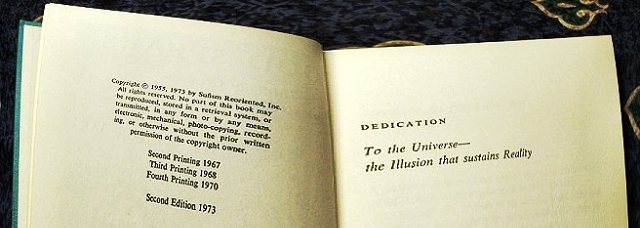 |
|
Here's my best understanding of this - using my own words. In The Evolution of Perception & the Cosmology of Substance, I explain everything away as a mere perceptual illusion, except the act of perception itself. The act of perception, I argue, is necessarily real. Everything else is an illusion. Concrete objects and their concreteness, energy, gravity, special relativity, language, thought, and number - even space and time - all can be explained as illusions of perception - explained in terms of evolved perceptual schemata, i.e. ways of perceiving, and shown to be illusions. But there is a caveat to this. Self-awareness (consciousness), while it too can be accounted for in this way, or better said - it can be shown to manifest out of this evolutionary process, cannot be an illusion. This is because, if perception is real (as stated above), and perception comes to perceive itself (becomes aware of itself, i.e. becomes self-aware), then self-awareness becomes a brute fact by definition - and is not an illusion. But - and this is the irony - this real self-awareness (consciousness), which is the very purpose of Creation, comes about as a result of illusion. It supervenes upon a set of illusory perceptual schemata that can then be discarded. This is why God Speaks is dedicated: To the Universe- the Illusion that sustains Reality. |
